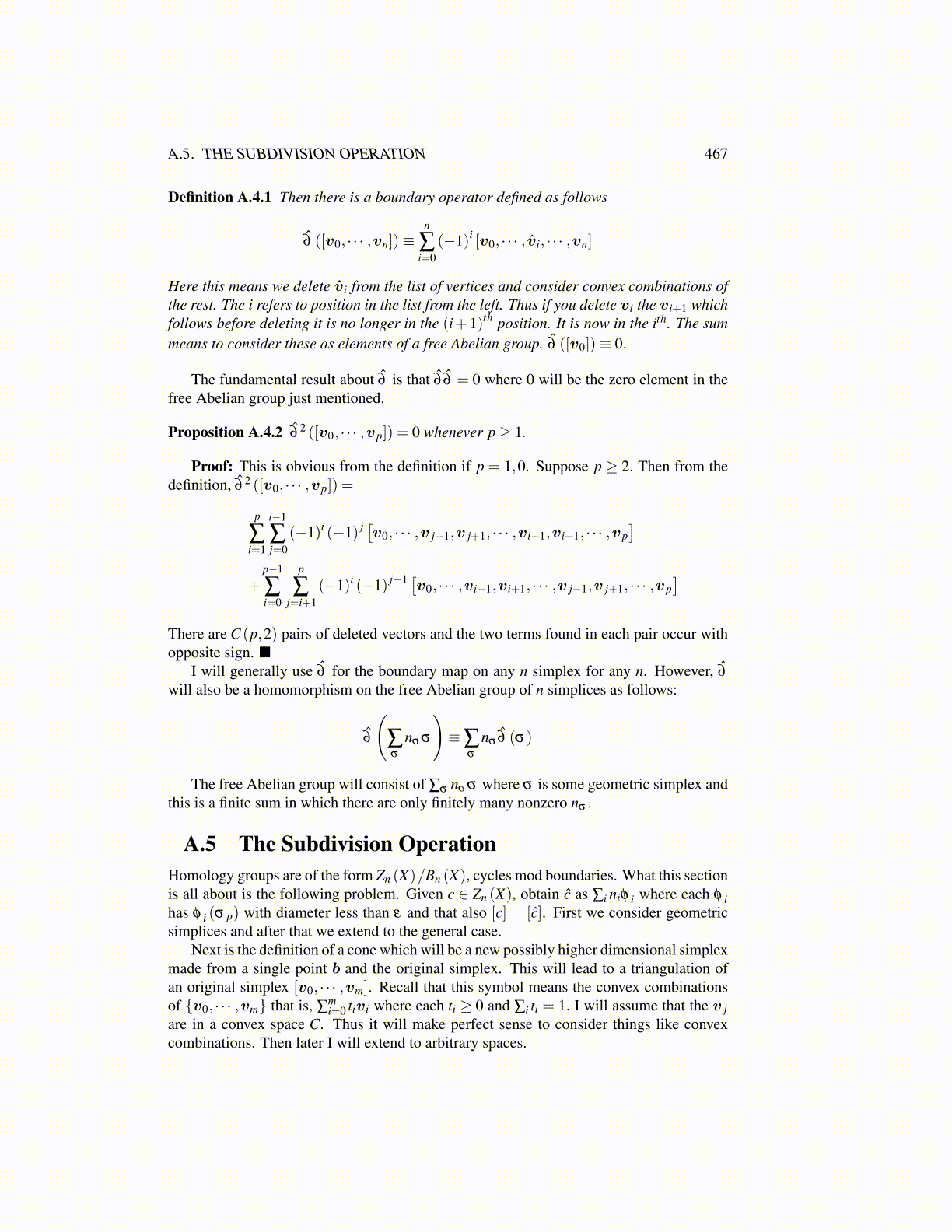
A.5. THE SUBDIVISION OPERATION 467
Definition A.4.1 Then there is a boundary operator defined as follows
∂̂ ([v0, · · · ,vn])≡n
∑i=0
(−1)i [v0, · · · , v̂i, · · · ,vn]
Here this means we delete v̂i from the list of vertices and consider convex combinations ofthe rest. The i refers to position in the list from the left. Thus if you delete vi the vi+1 whichfollows before deleting it is no longer in the (i+1)th position. It is now in the ith. The summeans to consider these as elements of a free Abelian group. ∂̂ ([v0])≡ 0.
The fundamental result about ∂̂ is that ∂̂ ∂̂ = 0 where 0 will be the zero element in thefree Abelian group just mentioned.
Proposition A.4.2 ∂̂ 2 ([v0, · · · ,vp]) = 0 whenever p≥ 1.
Proof: This is obvious from the definition if p = 1,0. Suppose p ≥ 2. Then from thedefinition, ∂̂ 2 ([v0, · · · ,vp]) =
p
∑i=1
i−1
∑j=0
(−1)i (−1) j [v0, · · · ,v j−1,v j+1, · · · ,vi−1,vi+1, · · · ,vp]
+p−1
∑i=0
p
∑j=i+1
(−1)i (−1) j−1 [v0, · · · ,vi−1,vi+1, · · · ,v j−1,v j+1, · · · ,vp]
There are C (p,2) pairs of deleted vectors and the two terms found in each pair occur withopposite sign. ■
I will generally use ∂̂ for the boundary map on any n simplex for any n. However, ∂̂
will also be a homomorphism on the free Abelian group of n simplices as follows:
∂̂
(∑σ
nσ σ
)≡∑
σ
nσ ∂̂ (σ)
The free Abelian group will consist of ∑σ nσ σ where σ is some geometric simplex andthis is a finite sum in which there are only finitely many nonzero nσ .
A.5 The Subdivision OperationHomology groups are of the form Zn (X)/Bn (X), cycles mod boundaries. What this sectionis all about is the following problem. Given c ∈ Zn (X), obtain ĉ as ∑i niφ i where each φ ihas φ i (σ p) with diameter less than ε and that also [c] = [ĉ]. First we consider geometricsimplices and after that we extend to the general case.
Next is the definition of a cone which will be a new possibly higher dimensional simplexmade from a single point b and the original simplex. This will lead to a triangulation ofan original simplex [v0, · · · ,vm]. Recall that this symbol means the convex combinationsof {v0, · · · ,vm} that is, ∑
mi=0 tivi where each ti ≥ 0 and ∑i ti = 1. I will assume that the v j
are in a convex space C. Thus it will make perfect sense to consider things like convexcombinations. Then later I will extend to arbitrary spaces.